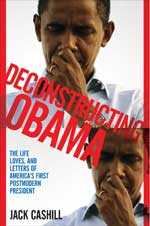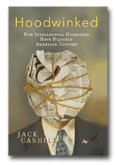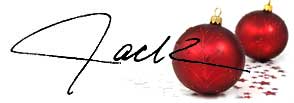Another Look at the Ayers-Obama Connection
Get your copy of Deconstructing Obama

___
Jack Cashill's book:
Hoodwinked: How Intellectual Hucksters have Hijacked American Culture

Click here for signed first edition
©Jack Cashill
WND.com - December 28, 2011
A little more than three years ago, I first posited on these pages the unwelcome truth that Bill Ayers was the primary craftsman behind Barack Obama’s acclaimed 1995 memoir, ““Dreams From My Father.”
So taboo was the subject, however, that in the years since not one critic, left or right, academic or journalistic, has dared to explore it in print.
To make such an exploration easy, I will volunteer to any serious critic my digital copies of “Dreams” and Ayers’s 2001 memoir, “Fugitive Days.”
To make it easier still, I will recommend that critics do what I did in a few spare hours over Christmas: cross-check just the first few pages of “Fugitive Days” with “Dreams” and follow the threads where they lead.
Here is what I found, much of it new to me.
- “Fugitive Days” opens in media res with a dramatic phone call. The 20-something Ayers learns that there has been an “accident.” Says the caller, “Diana is dead,” Ayers has a hard time understanding. “Diana is dead,” the caller “repeats slowly.” Ayers drops the line, and the conversation ends abruptly.
- “Dreams” also opens in media res with a dramatic phone call. The 20-something Obama learns that there has been an “accident.” The caller says, “Listen, Barry, your father is dead.” Obama has a hard time understanding. “Can you hear me?” she repeats. “I say, your father is dead.” The line is cut, and the conversation ends abruptly.
- Ayers imposes a fugitive’s worldview on Obama’s charmed life. In his own book’s opening, Ayers tells us that his world “spins further and further out of control.” Obama’s New York is “out of control” as well. Working in corporate New York, Obama sees himself as being “behind enemy lines.” More literally perhaps, Ayers and pals likewise find themselves “behind enemy lines.”
-
 As a fugitive, Ayers sees himself as “everywhere an outsider.” Obama also “knew how to live as an outsider” and feared that he “would forever remain an outsider.”
As a fugitive, Ayers sees himself as “everywhere an outsider.” Obama also “knew how to live as an outsider” and feared that he “would forever remain an outsider.”
- Ayers traces his alienation back to his youth when he first felt that “cold touch of abandonment.” Obama traces his alienation back to “the sense of abandonment [he’d] felt as a boy.”
- In this opening sequence Ayers uses the words “solitary” and “escape.” Obama will use the former word 12 times, the latter word 23. As a control, I checked my own semi-memoir, “Sucker Punch.” I use “escape” four times and “solitary” not at all.
- Not being on the run, Obama “had nothing to escape from except [his] own inner doubt.” Ayers has only scorn for those “untroubled by doubt.” He struggles with “doubts and fears,” “doubt and apprehension,” “doubts or questions.” Obama contends with “doubt and confusion,” “tension and doubt,” “anger and doubt.”
- Ayers confesses in his book’s opening to being “gripped suddenly with fear, then naked panic.” Says Obama, “I was gripped with panic. Then the panic gave way to anger.”
- Both authors inhabit a world of angry people, none more so than their indignant selves. Obama uses the word “angry” 23 times. We learn in “Dreams” of a man who “snorts like an angry bull.” The police in Ayers’s Chicago, their “nostrils flaring,” stampede through the streets “like angry cattle.”
- Ayers struggled with his “interior anger.” Obama endured an “interior struggle.”
-
 Ayers and Obama speak of “rage” the way that Eskimos do of snow—in so many varieties, so often, that they feel the need to qualify it, as Obama does when he speaks of “impressive rage,” “suppressed rage” or “coil of rage.”
Ayers and Obama speak of “rage” the way that Eskimos do of snow—in so many varieties, so often, that they feel the need to qualify it, as Obama does when he speaks of “impressive rage,” “suppressed rage” or “coil of rage.”
- Contra Dinesh D’Souza, the “roots of Obama’s rage” trace not to Obama Sr. but to Bill Ayers. In “Sucker Punch,” I do not speak of “anger” or “rage” in regards to myself at all.
- A few pages into “Fugitive Days,” Ayers tells us that his mother’s “script was already written.” He wants nothing to do “with the scripted lives we were expected to lead.”
- Obama too fears he is “living out a preordained script,” the same one that made his father a “captive to his tragedy.” The fact that Diana Oughton was a “captive to her own dreams,” writes Ayers, led to her tragic ending.
- To break out of such captivity, Ayers knew he had to “push the limits. Cross the borders.” Obama was not sure he could. “Instead,” says Obama, “I drew a series of circles around myself, with borders that shifted as time passed.”
- “I longed to run away and write my own story,” Ayers writes. Obama too wanted to construct “my story” out of the African American experience.
- “Fugitive Days” is laced with repeated reference to what Ayers calls “our constructed reality.” So too is “Dreams.” Obama describes his own early attempts at biography as “something I’d constructed from the scraps of information I’d picked up from my mother.”
- This was the first time I noticed the “scripted” metaphor, but as I detail in “Deconstructing Obama,” Ayers transformed Obama, elsewhere a stumbling literalist, into a sophisticated postmodernist.
- In both books there are multiple references to “constructs,” “stories,” “narratives,” “struggles,” “fictions,” “journeys,” “traps,” and even advanced bits of postmodern patois like the "grooves" into which they have fallen, the "poses" they assume, and the "stitched together" nature of the lives people lead. Most memoirs, my own included, avoid all this jabberwocky.
- In his memoir, Ayers often fuses the imperatives of the postmodernist with those of the fugitive as in the sentiment, “Our job was to create ourselves anew.” The key to that self-creation in both senses was “this one small hard thing: discipline.”
- Obama treasured these same virtues in Malcolm X. “His repeated acts of self-creation spoke to me,” says Obama. Malcolm’s words “promised a new and uncompromising order, martial on its discipline.”
- Not surprisingly, Ayers sees the need for “uncompromising militancy” and “uncompromising resistance.” He named his first child “Malik” in honor of Malcolm X’s Muslim designation.
- In the opening pages of “Fugitive Days,” Ayers introduces the concept of the “traveler,” again both literal and figurative, as in when he thanks “all those who traveled these fugitive roads.”
- When he proposes “to travel a narrower, more personal course,” Obama also uses “travel” existentially and, like Ayers, he employs it as a transitive verb with an object
- Both use the word “wander” in a variety of forms, literally and figuratively, Ayers 13 times, Obama 25. In “Sucker Punch,” I use the word “wander” once.
- A one-time merchant seaman, Ayers introduces his first nautical metaphor, “sinking ship,” just 600 words into his memoir. Obama also uses “sinking ship” metaphorically. In “Deconstructing Obama,” I identify at least 55 nautical words or phrases that both authors use. I match on fewer than ten.
- Ayers likes to use punchy action verbs. Here are those he uses in one form or another in the first 1000 words of “Fugitive Days”: groan, grip, flicker, choke, beat, bake, chatter, flutter, roar, explode, leap, pitch, rush, blow, scatter, scoop, sob, snatch, sink, slouch, stumble, struggle, spin, stagger, scratch, smudge, wobble, pump, plunge, pant, trample, whiz.
- Obama uses every one of these verbs, most of them multiple times, except for “whiz,” a word that Ayers only uses once. In “Sucker Punch,” I match on about half of these verbs, and mine is a book about boxing.
- Unaided, Obama tends to the awkward, passive and verbose. On his own, he was never capable of writing a publishable book, let alone one that Time Magazine would call “the best-written memoir ever produced by an American politician.”
The real scandal, as I have come to believe, is not that Ayers helped his struggling protégé, not even that Obama has continually lied about their relationship, but rather that the literary and media establishment has refused to investigate the most potentially consequential—and most obvious-- literary fraud of our time.
Webmaster's Note: Jack Cashill's Book-TV presentation of "Deconstructing Obama" can be viewed at http://www.c-spanvideo.org/program/298382-1
Editor's note: For a more complete account of this phenomenon, read Jack Cashill's amazing book, "Hoodwinked: How Intellectual Hucksters Have Hijacked American Culture.

